Electrospun Nanofibrous Membranes for Air Filtration: A Critical Review
Abstract
1. Introduction
2. Nature and Sources of Physical Pollutants
3. Air Filtration: Definitions
4. Use of Nanofibres for Air Filtration
5. Effects of the Electrospinning Process Parameters on the Filtration Effectiveness
6. Effects of the Electrospun Material on the Filtration Effectiveness
6.1. Polymer Nanofibres
6.2. Organic–Inorganic Nanofibres
6.3. Green Nanofibres
7. Effects of the Fibre and Filter Structure on the Filtration Effectiveness
Special Filtering Structures
8. Conclusions
Funding
Data Availability Statement
Conflicts of Interest
References
- Dziubak, T. Experimental investigation of possibilities to improve filtration efficiency of tangential inlet return cyclones by modification of their design. Energies 2022, 15, 3871. [Google Scholar] [CrossRef]
- Nam, C.; Lee, S.; Ryu, M.; Lee, J.; Lee, H. Electrospun nanofiber filters for highly efficient PM2.5 capture. Korean J. Chem. Eng. 2019, 36, 1565–1574. [Google Scholar] [CrossRef]
- Nadaf, A.; Gupta, A.; Hasan, N.; Ahmad, S.; Kesharwani, P.; Ahmad, F.J. Recent update on electrospinning and electrospun nanofibers: Current trends and their applications. RSC Adv. 2022, 12, 23808–23828. [Google Scholar] [CrossRef] [PubMed]
- National Park Service. Where Does Air Pollution Come From? Available online: www.nps.gov (accessed on 23 June 2023).
- Su, J.; Huang, G.; Zhang, Z. Migration and diffusion characteristics of air pollutants and meteorological influences in Northwest China: A case study of four mining areas. Environ. Sci. Poll. Res. 2022, 29, 55003–55025. [Google Scholar] [CrossRef]
- Zhang, G.; Ding, C.; Jiang, X.; Pan, C.; Wei, X.; Sun, Y. Chemical Compositions and Sources Contribution of Atmospheric Particles at a Typical Steel Industrial Urban Site. Sci. Rep. 2020, 10, 7654. [Google Scholar] [CrossRef]
- World Health Organization. Sulfur Oxides and Suspended Particulate Matter. Available online: www.who.int (accessed on 23 June 2023).
- Carleton, T.A.; Hsiang, S.M. Social and economic impacts of climate. Science 2016, 353, aad9837. [Google Scholar] [CrossRef] [PubMed]
- Behera, S.; Radha, N.; Tanuku, S.; Rama, S.; Moturi, K.; Gudapati, G.; Tadi, S.R.; Modali, S. Anthropogenic impact and antibiotic resistance among the indicator and pathogenic bacteria from several industrial and sewage discharge points along the coast from Pydibhimavaram to Tuni, East Coast of India. Environ. Monit. Assess. 2023, 195, 546. [Google Scholar] [CrossRef]
- Environmental Protection Agency. Health and Environmental Effects of Particulate Matter (PM). Available online: www.epa.gov/pm-pollution/health-and-environmental-effects-particulate-matter-pm (accessed on 23 June 2023).
- Center for Disease Control and Prevention, Healthy Housing Reference Manual, Chapter 5: Indoor Air Pollutants and Toxic Materials. Available online: https://www.cdc.gov/nceh/publications/books/housing/cha05.htm (accessed on 23 June 2023).
- World Health Organization. 7 Million Premature Deaths Annually Linked to Air Pollution. Available online: www.who.int/news/item/25-03-2014-7-million-premature-deaths-annually-linked-to-air-pollution (accessed on 23 June 2023).
- Thompson, R.C.; Olsen, Y.; Mitchell, R.P.; Davis, A.; Rowland, S.J.; John, A.W.G.; McGonigle, D.; Russell, A.E. Lost at Sea: Where Is All the Plastic? Science 2004, 304, 5672. [Google Scholar] [CrossRef]
- Yadav, S.; Kataria, N.; Khyalia, P.; Kumar Rose, P.; Mukherjee, S.; Sabherwal, H.; Chai, W.S.; Rajendran, S.; Jiang, J.J.; Khoo, K.S. Recent analytical techniques, and potential eco-toxicological impacts of textile fibrous microplastics (FMPs) and associated contaminates: A review. Chemosphere 2003, 326, 138495. [Google Scholar] [CrossRef]
- Chen, G.; Feng, Q.; Wang, J. Mini-review of microplastics in the atmosphere and their risk to humans. Sci. Total Environ. 2020, 703, 135504. [Google Scholar] [CrossRef]
- Allen, S.; Allen, D.; Phoenix, V.R.; Le Roux, G.; Durántez Jiménez, P.; Simonneau, A.; Binet, S.; Galop, D. Atmospheric transport and deposition of microplastics in a remote mountain catchment. Nature Geosci. 2019, 12, 339–344. [Google Scholar] [CrossRef]
- Liu, K.; Wang, X.; Fang, T.; Xu, P.; Zhu, L.; Li, D. Source and potential risk assessment of suspended atmospheric microplastics in Shanghai. Sci. Total Environ. 2019, 675, 462–471. [Google Scholar] [CrossRef] [PubMed]
- Cai, L.; Wang, J.; Peng, J.; Tan, Z.; Zhan, Z.; Tan, X.; Chen, Q. Characteristic of microplastics in the atmospheric fallout from Dongguan city, China: Preliminary research and first evidence. Environ. Sci. Pollut. Res. 2017, 24, 24928–24935. [Google Scholar] [CrossRef] [PubMed]
- Barrows, A.P.W.; Cathey, S.E.; Petersen, C.W. Marine environment microfiber contamination: Global patterns and the diversity of microparticle origins. Environ. Pollut. 2018, 237, 275–284. [Google Scholar] [CrossRef]
- Perera, K.; Ziajahromi, S.; Nash, S.B.; Manage, P.M.; Leusch, F.D.L. Airborne Microplastics in Indoor and Outdoor Environments of a Developing Country in South Asia: Abundance, Distribution, Morphology, and Possible Sources. Environ. Sci. Technol. 2022, 56, 16676–16685. [Google Scholar] [CrossRef] [PubMed]
- Chen, Y.; Li, X.; Zhang, X.; Zhang, Y.; Gao, W.; Wang, R.; He, D. Air conditioner filters become sinks and sources of indoor microplastics fibers. Environ. Poll. 2022, 292, 118465. [Google Scholar] [CrossRef]
- Guo, Y.; Liu, Y.; Xiang, T.; Li, J.; Lv, M.; Yan, Y.; Zhao, J.; Sun, J.; Yang, X.; Liao, C.; et al. Disposable Polypropylene Face Masks: A Potential Source of Micro/Nanoparticles and Organic Contaminates in Humans. Environ. Sci. Technol. 2023, 57, 5739–5750. [Google Scholar] [CrossRef]
- Sankhyan, S.; Heinselman, K.R.; Ciesielski, P.N.; Barnes, T.; Himmel, M.E.; Teed, H.; Patel, S.; Vance, M.E. Filtration Performance of Layering Masks and Face Coverings and the Reusability of Cotton Masks after Repeated Washing and Drying. Aerosol Air Qual. Res. 2021, 21, 210117. [Google Scholar] [CrossRef]
- Sullivan, G.L.; Delgado-Gallardo, J.; Watson, T.M.; Sarp, S. An investigation into the leaching of micro and nano particles and chemical pollutants from disposable face masks-linked to the COVID-19 pandemic. Water Res. 2021, 196, 117033. [Google Scholar] [CrossRef]
- Ma, J.; Chen, F.; Xu, H.; Jiang, H.; Liu, J.; Li, P.; Chen, C.C.; Pan, K. Face masks as a source of nanoplastics and microplastics in the environment: Quantification, characterization, and potential for bioaccumulation. Environ. Pollut. 2021, 288, 117748. [Google Scholar] [CrossRef]
- Yang, C. Aerosol Filtration Application Using Fibrous Media—An Industrial Perspective. Chin. J. Chem. Eng. 2012, 20, 1–9. [Google Scholar] [CrossRef] [PubMed]
- Huang, S.H.; Chen, C.W.; Kuo, Y.M.; Lai, C.Y.; McKay, R.; Chen, C.C. Factors affecting filter penetration and quality factor of particulate respirators. Aerosol Air Qual. Res. 2013, 13, 162–171. [Google Scholar] [CrossRef]
- Han, S.; Kim, J.; Ko, S.H. Advances in air filtration technologies: Structure-based and interaction-based approaches. Mater. Today Adv. 2021, 9, 100134. [Google Scholar] [CrossRef]
- Zhang, S.; Rind, N.A.; Tang, N.; Liu, H.; Yin, X.; Yu, J.; Ding, B. Electrospun Nanofibres for Air Filtration. In Electrospinning: Nanofabrication and Applications; Ding, B., Wang, X., Yu, J., Eds.; Elsevier: Amsterdam, The Netherlands, 2019. [Google Scholar] [CrossRef]
- Xue, J.; Wu, T.; Dai, Y.; Xia, Y. Electrospinning and Electrospun Nanofibers: Methods, Materials, and Applications. Chem. Rev. 2019, 119, 5298–5415. [Google Scholar] [CrossRef] [PubMed]
- Haider, A.; Haider, S.; Kang, I.K. A comprehensive review summarizing the effect of electrospinning parameters and potential applications of nanofibers in biomedical and biotechnology. Arabian J. Chem. 2018, 11, 1165–1188. [Google Scholar] [CrossRef]
- Khajavi, R.; Abbasipour, M. Controlling nanofiber morphology by the electrospinning process. In Woodhead Publishing Series in Textiles, Electrospun Nanofibers; Afshari, M., Ed.; Woodhead Publishing: Sawston, UK, 2017; pp. 109–123. ISBN 9780081009079. [Google Scholar] [CrossRef]
- Taylor, G. Disintegration of Water Drops in an Electric Field. Proc. R. Soc. Lond. A 1964, 280, 383–397. [Google Scholar]
- Cloupeau, M.; Prunet-Foch, B. Electrostatic spraying of liquids in cone-jet mode. J. Electrost. 1989, 22, 135–159. [Google Scholar] [CrossRef]
- Doshi, J.; Reneker, D.H. Electrospinning Process and Applications of Electrospun Fibres. J. Electrost. 1995, 35, 151–160. [Google Scholar] [CrossRef]
- Raksa, A.; Numpaisal, P.; Ruksakulpiwat, Y. The effect of humidity during electrospinning on morphology and mechanical properties of SF/PVA nanofibers. Mat. Today Proc. 2021, 47, 3458–3461. [Google Scholar] [CrossRef]
- Li, Y.; Zhu, J.; Cheng, H.; Li, G.; Cho, H.; Jiang, M.; Gao, Q.; Zhang, X. Developments of Advanced Electrospinning Techniques: A Critical Review. Adv. Mater. Technol. 2021, 6, 2100410. [Google Scholar] [CrossRef]
- Pereao, O.K.; Bode-Aluko, C.; Ndayambaje, G.; Fatoba, O.; Petrik, L.F. Electrospinning: Polymer nanofibre adsorbent applications for metal ion removal. J. Polym. Environ. 2017, 25, 1175–1189. [Google Scholar] [CrossRef]
- Al-Attabi, R.; Dumee, L.F.; Kong, L.; Schütz, J.A.; Morsi, Y. High efficiency poly(acrylonitrile) electrospun nanofibre membranes for airborne nanomaterials filtration. Adv. Eng. Mater. 2017, 20, 1700572. [Google Scholar] [CrossRef]
- Al-Attabi, R.; Dumee, L.F.; Schütz, J.A.; Morsi, Y. Pore engineering towards highly efficient electrospun nanofibrous membranes for aerosol particle removal. Sci. Total Environ. 2018, 625, 706–715. [Google Scholar] [CrossRef]
- Naragund, V.S.; Panda, P.K. Electrospun polyacrylonitrile nanofibre membranes for air filtration application. Int. J. Environ. Sci. Technol. 2021, 19, 10233–10244. [Google Scholar] [CrossRef]
- Lee, H.; Jeon, S. Polyacrylonitrile nanofibre membranes modified with Ni-based conductive metal organic frameworks for air filtration and respiration monitoring. ACS Appl. Nano Mater. 2020, 3, 8192–8198. [Google Scholar] [CrossRef]
- Yadav, D.; Karunanithi, A.; Saxena, S.; Shukla, S. Modified PVA membrane for separation of micro-emulsion. Sci. Total Environ. 2022, 822, 153610. [Google Scholar] [CrossRef]
- Guo, Y.; He, W.; Liu, J. Electrospinning polyethylene terephthalate/SiO2 nanofibre composite needle felt for enhanced filtration performance. J. Appl. Polym. Sci. 2020, 137, 48282. [Google Scholar] [CrossRef]
- Park, D.; Kim, M.; Lee, S.; Yoon, I.J.; Lee, K.; Lee, M.H.; Nah, J. Light-permeable air filter with self-polarized nylon-11 nanofibres for enhanced trapping of particulate matters. Adv. Mater. Interface 2019, 6, 1801832. [Google Scholar] [CrossRef]
- Pepe, Y.; Akkoyun, S.; Karatay, A.; Yildiz, A.E.; Unver, H.; Ates, A.; Elmali, A. Morphology, defects and polymer concentration related nonlinear absorption and optical limiting properties of electrospun polyamide 6 nanofibres. J. Appl. Polym. Sci. 2022, 139, 52281. [Google Scholar] [CrossRef]
- Juraij, K.; Chingakham, C.; Manaf, O.; Sagitha, P.; Suni, V.; Sajith, V.; Sujith, A. Polyurethane/multi-walled carbon nanotube electrospun composite membrane for oil/water separation. J. Appl. Polym. Sci. 2022, 139, 52117. [Google Scholar] [CrossRef]
- Soulegani, S.R.; Sherafat, Z.; Rasouli, M. Morphology, physical, and mechanical properties of potentially applicable coelectrospun polysulfone/chitosan-polyvinyl alcohol fibrous membranes in water purification. J. Appl. Polym. Sci. 2021, 138, 49933. [Google Scholar] [CrossRef]
- Balgis, R.; Murata, H.; Goi, Y.; Ogi, T.; Okuyama, K.; Bao, L. Synthesis of dual-size cellulose–polyvinylpyrrolidone nanofibre composites via one-step electrospinning method for high-performance air filter. Langmuir 2017, 33, 6127–6134. [Google Scholar] [CrossRef] [PubMed]
- Cai, R.R.; Li, S.Z.; Zhang, L.Z.; Lei, Y. Fabrication and performance of a stable micro/nano composite electret filter for effective PM2.5 capture. Sci. Total Environ. 2020, 725, 138297. [Google Scholar] [CrossRef] [PubMed]
- Li, X.; Wang, C.; Huang, X.; Zhang, T.; Wang, X.; Min, M.; Wang, L.; Huang, H.; Hsiao, B.S. Anionic surfactant-triggered Steiner geometrical poly(vinylidene fluoride) nanofibre/nanonet air filter for efficient particulate matter removal. ACS Appl. Mater. Interfaces 2018, 10, 42891–42904. [Google Scholar] [CrossRef] [PubMed]
- Lv, S.; Zhao, X.; Shi, L.; Zhang, G.; Wang, S.; Kang, W.; Zhuang, X. Preparation and properties of sc-PLA/PMMA transparent nanofibre air filter. Polymers 2018, 10, 996. [Google Scholar] [CrossRef]
- Sun, N.; Shao, W.; Zheng, J.; Zhang, Y.; Li, J.; Liu, S.; Wang, K.; Niu, J.; Li, B.; Gao, Y.; et al. Fabrication of fully degradable branched poly (lactic acid) nanofiber membranes for high-efficiency filter paper materials. J. Appl. Polym. Sci. 2022, 139, e53186. [Google Scholar] [CrossRef]
- Liu, H.; Zhang, S.; Liu, L.; Yu, J.; Ding, B. A Fluffy Dual-Network Structured Nanofiber/Net Filter Enables High-Efficiency Air Filtration. Adv. Funct. Mater. 2019, 29, 1904108. [Google Scholar] [CrossRef]
- Zhou, M.; Fang, M.; Quan, Z.; Zhang, H.; Qin, X.; Wang, R.; Yu, J. Large-scale preparation of micro-gradient structured sub-micro fibrous membranes with narrow diameter distributions for high-efficiency air purification. Environ. Sci. Nano 2019, 6, 3560–3578. [Google Scholar] [CrossRef]
- Farhangian, M.; Dehghan, S.F.; Jafari, M.J.; Pirposhteh, E.A.; Khalilinejad, A.; Tavakol, E. Feasibility study on the application of electrospun nanofibre webs for the air sampling of crystalline silica. Ind. Health 2021, 59, 415–426. [Google Scholar] [CrossRef]
- Liu, B.; Zhang, S.; Wang, X.; Yu, J.; Ding, B. Efficient and reusable polyamide-56 nanofiber/nets membrane with bimodal structures for air filtration. J. Colloid Interface Sci. 2015, 457, 203–211. [Google Scholar] [CrossRef]
- Liu, H.; Zhang, S.; Liu, L.; Yu, J.; Ding, B. High-Performance PM 0.3 Air Filters Using Self-Polarized Electret Nanofiber/Nets. Adv. Funct. Mater. 2020, 30, 1909554. [Google Scholar] [CrossRef]
- Han, W.; Rao, D.; Gao, H.; Yang, X.; Fan, H.; Li, C.; Dong, L.; Meng, H. Green-solvent-processable biodegradable poly(lactic acid) nanofibrous membranes with bead-on-string structure for effective air filtration: “Kill two birds with one stone”. Nano Energy 2022, 97, 107237. [Google Scholar] [CrossRef]
- Orlando, R.; Polat, M.; Afshari, A.; Johnson, M.S.; Fojan, P. Electrospun nanofibre air filters for particles and gaseous pollutants. Sustainability 2021, 13, 6553. [Google Scholar] [CrossRef]
- Liu, F.; Li, M.; Li, F.; Weng, K.; Qi, K.; Liu, C.; Ni, Q.; Tao, X.; Zhang, J.; Shao, W.; et al. Preparation and Properties of PVDF/Fe3O4 Nanofibers with Magnetic and Electret Effects and their Application in Air Filtration. Macromol. Mater. Eng. 2020, 305, 1900856. [Google Scholar] [CrossRef]
- Dai, H.; Liu, X.; Zhang, C.; Ma, K.; Zhang, Y. Electrospinning Polyacrylonitrile/Graphene Oxide/Polyimide Nanofibrous Membranes for High-efficiency PM2.5 Filtration. Sep. Purif. Technol. 2021, 276, 119243. [Google Scholar] [CrossRef]
- Zhang, S.; Tang, N.; Cao, L.; Yin, X.; Yu, J.; Ding, B. Highly Integrated Polysulfone/ Polyacrylonitrile/Polyamide-6 Air Filter for Multilevel Physical Sieving Airborne Particles. ACS Appl. Mater. Interfaces 2016, 8, 29062–29072. [Google Scholar] [CrossRef]
- Cogliano, V.J.; Baan, R.; Straif, K.; Grosse, Y. Preventable exposures associated with human cancers. J. Nat. Cancer. Instr. 2011, 103, 1827–1839. [Google Scholar] [CrossRef]
- Centers For Disease Control and Prevention. Preventing Silicosis and Deaths from Sandblasting; NIOSH Publications: Washington, DC, USA, 1992. Available online: https://www.cdc.gov/niosh/docs/92-102/ (accessed on 23 June 2023).
- Liu, Z.; Wei, Z.; Long, S.; Wang, X.; Yang, J. Solvent-resistant polymeric microfiltration membranes based on oxidized electrospun poly (arylene sulfide sulfone) nanofibres. J. Appl. Polym. Sci. 2020, 137, 48506. [Google Scholar] [CrossRef]
- Wei, Z.; Su, Q.; Yang, J.; Zhang, G.; Long, S.; Wang, X. High-performance filter membrane composed of oxidized Poly (arylene sulfide sulfone) nanofibres for the high-efficiency air filtration. J. Hazard Mater. 2021, 417, 126033. [Google Scholar] [CrossRef]
- Dinç, S.D.; Göktepe, F. Production and analysis of electrospun PA 6,6 and PVA nanofibrous surfaces for filtration. Ind. Textila 2021, 72, 552–560. [Google Scholar] [CrossRef]
- Lakshmanan, A.; Sarngan, P.P.; Sarkar, D. Inorganic-organic nanofibre networks with antibacterial properties for enhanced particulate filtration: The critical role of amorphous titania. Chemosphere 2022, 286, 131671. [Google Scholar] [CrossRef] [PubMed]
- Linsebigler, A.L.; Lu, G.; Yates, J.T. Photocatalysis on TiO2 surfaces: Principles, mechanisms, and selected results. Chem. Rev. 1995, 95, 735–758. [Google Scholar] [CrossRef]
- Hoffmann, M.R.; Martin, S.T.; Choi, W.; Bahnemann, D.W. Environmental applications of semiconductor photocatalysis. Chem. Rev. 1995, 95, 69–96. [Google Scholar] [CrossRef]
- Nagaveni, K.; Sivalingam, G.; Hegde, M.S.; Madras, G. Photocatalytic degradation of organic compounds over combustion-synthesized nano-TiO2. Environ. Sci. Technol. 2004, 38, 1600–1604. [Google Scholar] [CrossRef] [PubMed]
- Bortolassi, A.C.C.; Guerra, V.G.; Aguiar, M.L.; Soussan, L.; Cornu, D.; Miele, P.; Bechelany, M. Composites based on nanoparticle and PAN electrospun nanofibre membranes for air filtration and bacterial removal. Nanomat. 2019, 9, 1740. [Google Scholar] [CrossRef]
- Robert, B.; Nallathambi, G. Indoor formaldehyde removal by catalytic oxidation, adsorption and nanofibrous membranes: A review. Environ. Chem. Lett. 2020, 19, 2551–2579. [Google Scholar] [CrossRef]
- Hu, M.; Yin, L.; Zhou, H.; Wu, L.; Yuan, K.; Pan, B.; Zhong, Z.; Xing, W. Manganese dioxide-filled hierarchical porous nanofibre membrane for indoor air cleaning at room temperature. J. Membr. Sci. 2020, 605, 118094. [Google Scholar] [CrossRef]
- Kim, J.; Hong, S.C.; Bae, G.N.; Jung, J.H. Electrospun magnetic nanoparticle-decorated nanofibre filter and its applications to high-efficiency air filtration. Environ. Sci. Technol. 2017, 51, 11967–11975. [Google Scholar] [CrossRef]
- Lv, D.; Zhu, M.; Jiang, Z.; Jiang, S.; Zhang, Q.; Xiong, R.; Huang, C. Green electrospun nanofibers and their application in air filtration. Macromol. Mater. Eng. 2018, 303, 1800336. [Google Scholar] [CrossRef]
- Keleş, M.K.; Uysal, Y. Production of a microfiltration membrane from acrylic fibre (AF) and low-density polyethylene (LDPE) shrink film wastes. Clean Technol. Environ. Policy 2021, 23, 1431–1442. [Google Scholar] [CrossRef]
- Cho, C.J.; Chang, J.S.; Lin, Y.Z.; Jiang, D.H.; Chen, W.H.; Lin, W.Y.; Chen, C.W.; Rwei, S.P.; Kuo, C.C. Green electrospun nanofiber membranes filter prepared from novel biomass thermoplastic copolyester: Morphologies and filtration properties. J. Taiwan Inst. Chem. Eng. 2022, 106, 206–214. [Google Scholar] [CrossRef]
- Jiang, S.; Hou, H.; Agarwal, S.; Greiner, A. Polyimide nanofibres by “Green” electrospinning via aqueous solution for filtration applications. ACS Sustain. Chem. Eng. 2016, 4, 4797–4804. [Google Scholar] [CrossRef]
- Souzandeh, H.; Wang, Y.; Netravali, A.N.; Zhong, W.H. Towards sustainable and multifunctional air-filters: A review on biopolymer-based filtration materials. Polym. Rev. 2019, 59, 651–686. [Google Scholar] [CrossRef]
- Lomonaco, T.; Manco, E.; Corti, A.; La Nasa, J.; Ghimenti, S.; Biagini, D.; Di Francesco, F.; Modugno, F.; Ceccarini, A.; Fuoco, R. Release of harmful volatile organic compounds (VOCs) from photo-degraded plastic debris: A neglected source of environmental pollution. J. Hazard. Mater. 2020, 394, 122596. [Google Scholar] [CrossRef]
- Cabanes, A.; Valdés, F.; Fullana, A. A review on VOCs from recycled plastics. Sustain. Mater. Technol. 2020, 25, e00179. [Google Scholar] [CrossRef]
- Singh, R.P.; Mishra, S.; Das, A.P. Synthetic microfibres: Pollution toxicity and remediation. Chemosphere 2020, 257, 127199. [Google Scholar] [CrossRef]
- Cui, J.; Lu, T.; Li, F.; Wang, Y.; Lei, J.; Ma, W.; Zou, Y.; Huang, C. Flexible and transparent composite nanofibre membrane that was fabricated via a “green” electrospinning method for efficient particulate matter 2.5 capture. J. Colloid Interface Sci. 2021, 582, 506–514. [Google Scholar] [CrossRef] [PubMed]
- Pan, W.; Wang, J.P.; Sun, X.B.; Wang, X.X.; Jiang, J.; Zhang, Z.G.; Li, P.; Qu, C.H.; Long, Y.Z.; Yu, G.F. Ultra uniform metal−organic framework-5 loading along electrospun chitosan/polyethylene oxide membrane fibres for efficient PM2.5 removal. J. Cleaner Prod. 2021, 29, 125270. [Google Scholar] [CrossRef]
- Logan, M.W.; Langevin, S.; Xia, Z. Reversible Atmospheric Water Harvesting Using Metal-Organic Frameworks. Sci. Rep. 2020, 10, 1492. [Google Scholar] [CrossRef]
- Seddiqi, H.; Oliaei, E.; Honarkar, H.; Jin, J.; Geonzon, L.C.; Bacabac, R.G.; Klein-Nulend, J. Cellulose and its derivatives: Towards biomedical applications. Cellulose 2021, 28, 1893–1921. [Google Scholar] [CrossRef]
- Li, B.; Yang, X. Preparation and characterization of electrospun cellulose acetate/poly (ethylene oxide) fiber membrane for air filtration. Polym. Bull. 2023, 80, 4841–4858. [Google Scholar] [CrossRef]
- Kadam, V.V.; Wang, L.; Padhye, R. Electrospun nanofibre materials to filter air pollutants—A review. J. Ind. Text. 2018, 47, 2253–2280. [Google Scholar] [CrossRef]
- Liu, Y.; Cheong, S.N.G.; Yu, J.; Tsai, W.B. Modification and crosslinking of gelatin-based biomaterials as tissue adhesives. Colloids Surf. B 2019, 174, 316–323. [Google Scholar] [CrossRef] [PubMed]
- Souzandeh, H.; Molki, B.; Zheng, M.; Beyenal, H.; Scudiero, L.; Wang, Y.; Zhong, W.H. Cross-linked protein nanofilter with antibacterial properties for multifunctional air filtration. ACS Appl. Mater. Interfaces 2017, 9, 22846. [Google Scholar] [CrossRef]
- Kadam, V.; Truong, Y.B.; Schutz, J.; Kyratzis, I.L.; Padhye, R.; Wang, L. Gelatin/β–Cyclodextrin Bio–Nanofibres as respiratory filter media for filtration of aerosols and volatile organic compounds at low air resistance. J. Hazard Mater. 2021, 403, 123841. [Google Scholar] [CrossRef] [PubMed]
- Zhang, H.; Zhen, Q.; Cui, J.Q.; Sun, H.W.; Liu, R.T.; Zhang, Y.F.; Liu, Y. Binary Structured Polypropylene/Polyethylene Glycol Micro-nanofibrous Membranes with Enhanced Water and Air Permeability. Fibers Polym. 2021, 22, 69–76. [Google Scholar] [CrossRef]
- Rashid, T.U.; Gorga, R.E.; Krause, W.E. Mechanical properties of electrospun fibres—A critical review. Adv. Eng. Mater. 2021, 23, 2100153. [Google Scholar] [CrossRef]
- Qin, X.H.; Wang, S.Y. Filtration properties of electrospinning nanofibres. J. Appl. Polym. Sci. 2006, 102, 1285–1290. [Google Scholar] [CrossRef]
- Kimmer, D.; Vincent, I.; Fenyk, J.; Petras, D.; Zatloukal, M.; Sambaer, W.; Zdimal, V. Morphology of nano and micro fibre structures in ultrafine particles filtration. AIP Conf. Proc. 2011, 1375, 295–311. [Google Scholar] [CrossRef]
- He, R.; Li, J.; Chen, M.; Zhang, S.; Cheng, Y.; Ning, X.; Wang, N. Tailoring moisture electroactive Ag/Zn@cotton coupled with electrospun PVDF/PS nanofibres for antimicrobial face masks. J. Hazard Mat. 2022, 428, 128239. [Google Scholar] [CrossRef]
- Chen, X.; Xu, Y.; Liang, M.; Ke, Q.; Fang, Y.; Xu, H.; Jin, X.; Huang, C. Honeycomb-like polysulphone/polyurethane nanofibre filter for the removal of organic/inorganic species from air streams. J. Hazard Mater. 2018, 347, 325–333. [Google Scholar] [CrossRef] [PubMed]
- Xu, Y.; Zhang, X.; Hao, X.; Teng, D.; Zhao, T.; Zeng, Y. Micro/nanofibrous nonwovens with high filtration performance and radiative heat dissipation property for personal protective face mask. Chem. Eng. J. 2021, 423, 130175. [Google Scholar] [CrossRef] [PubMed]


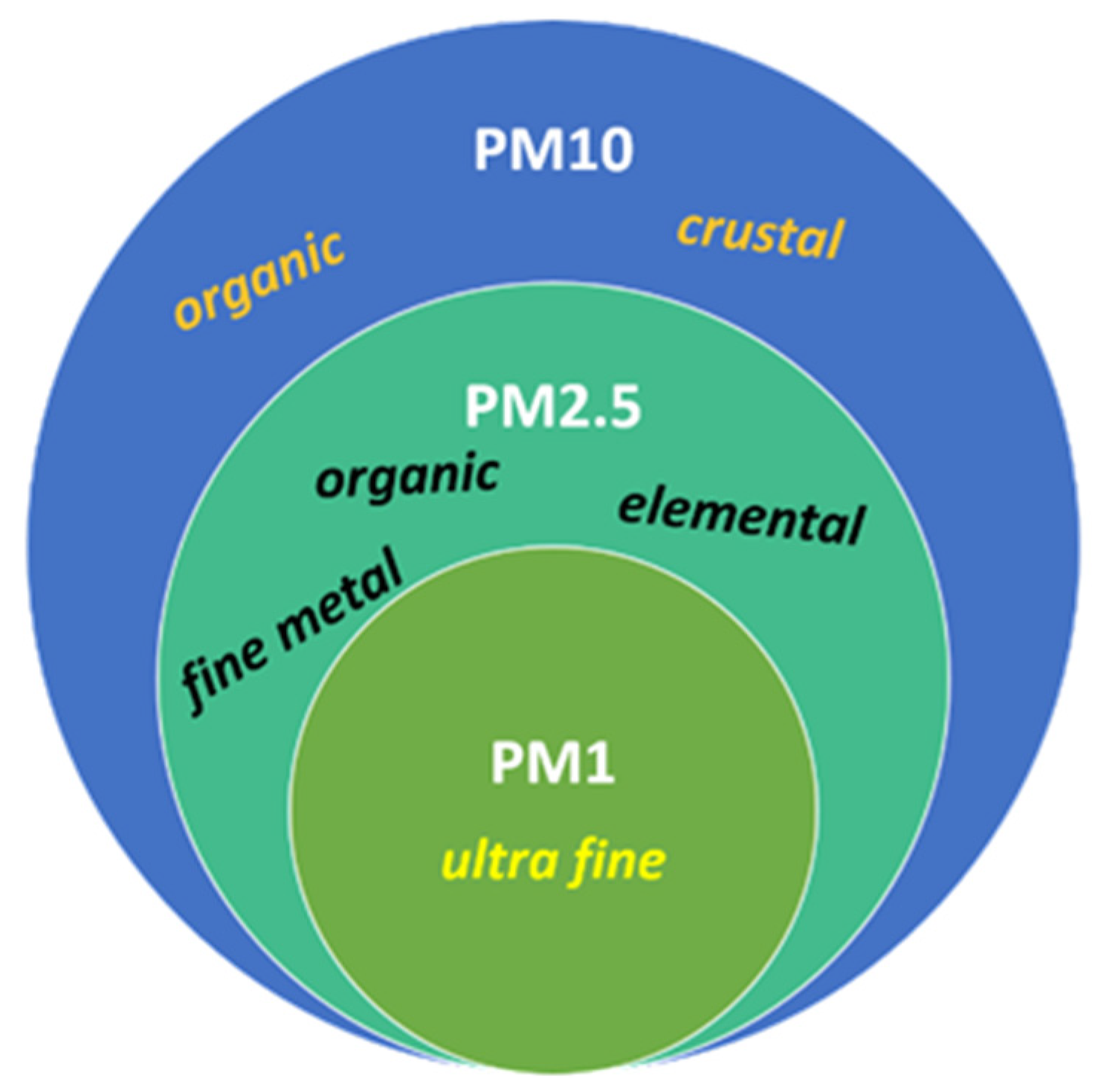
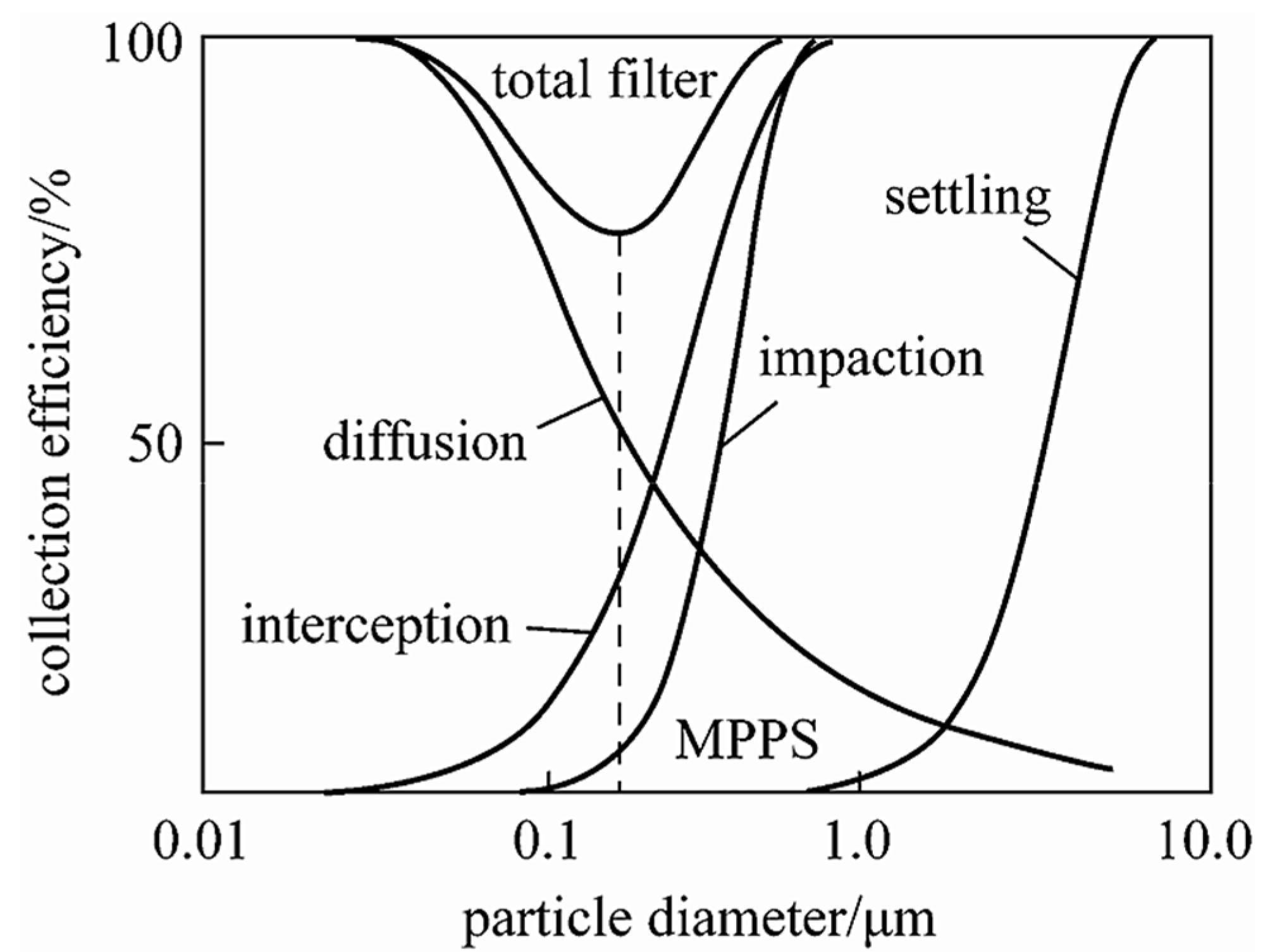
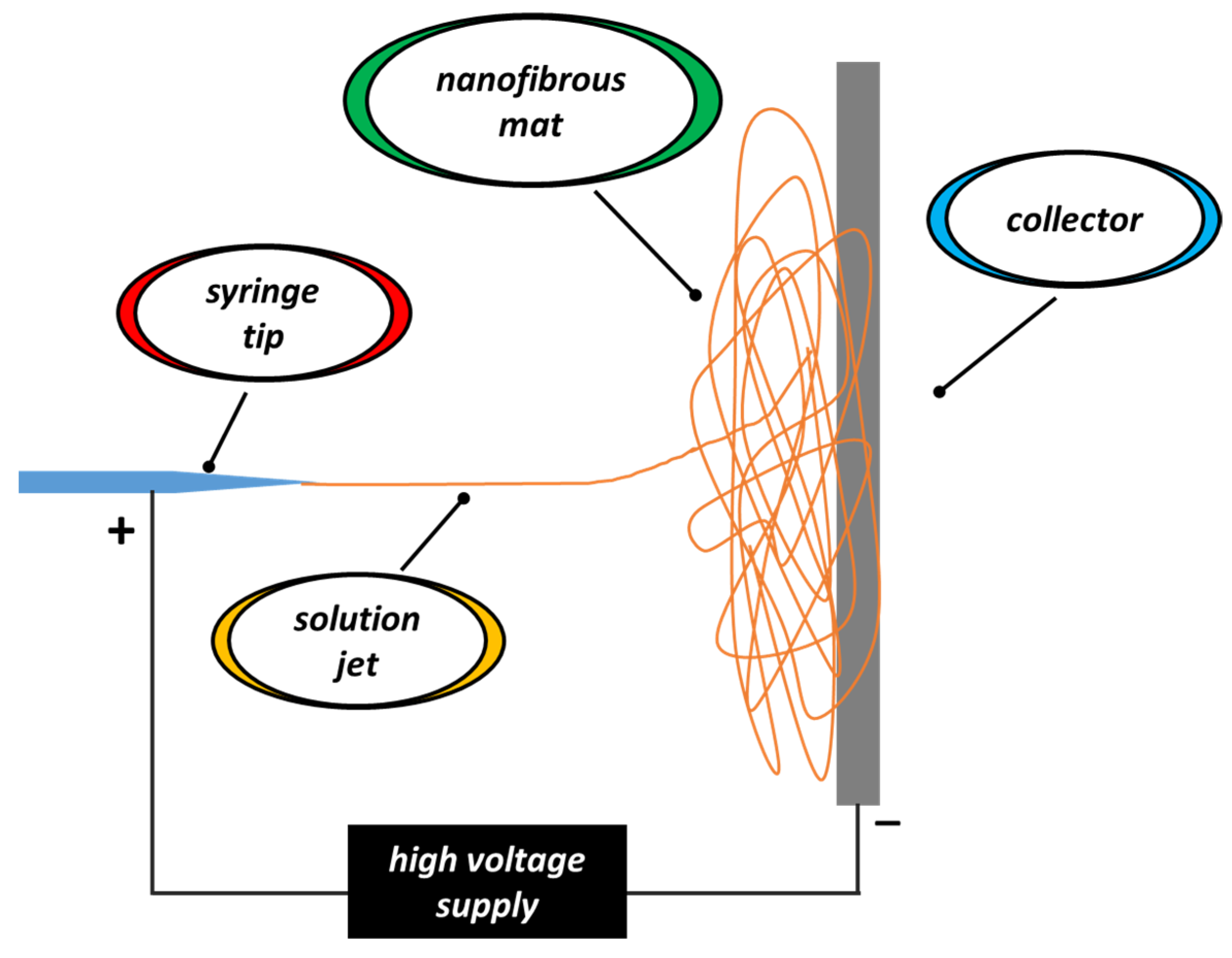

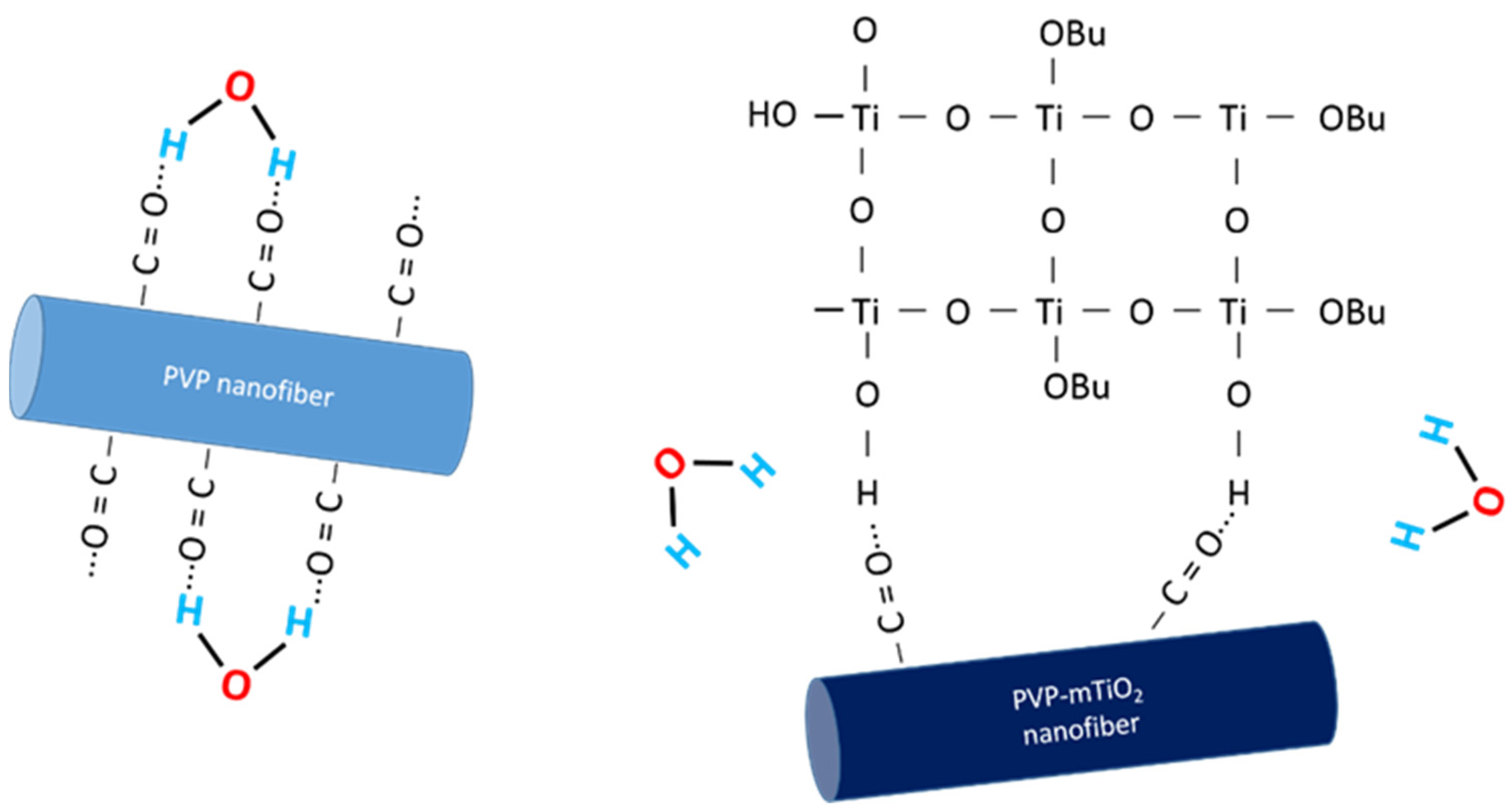
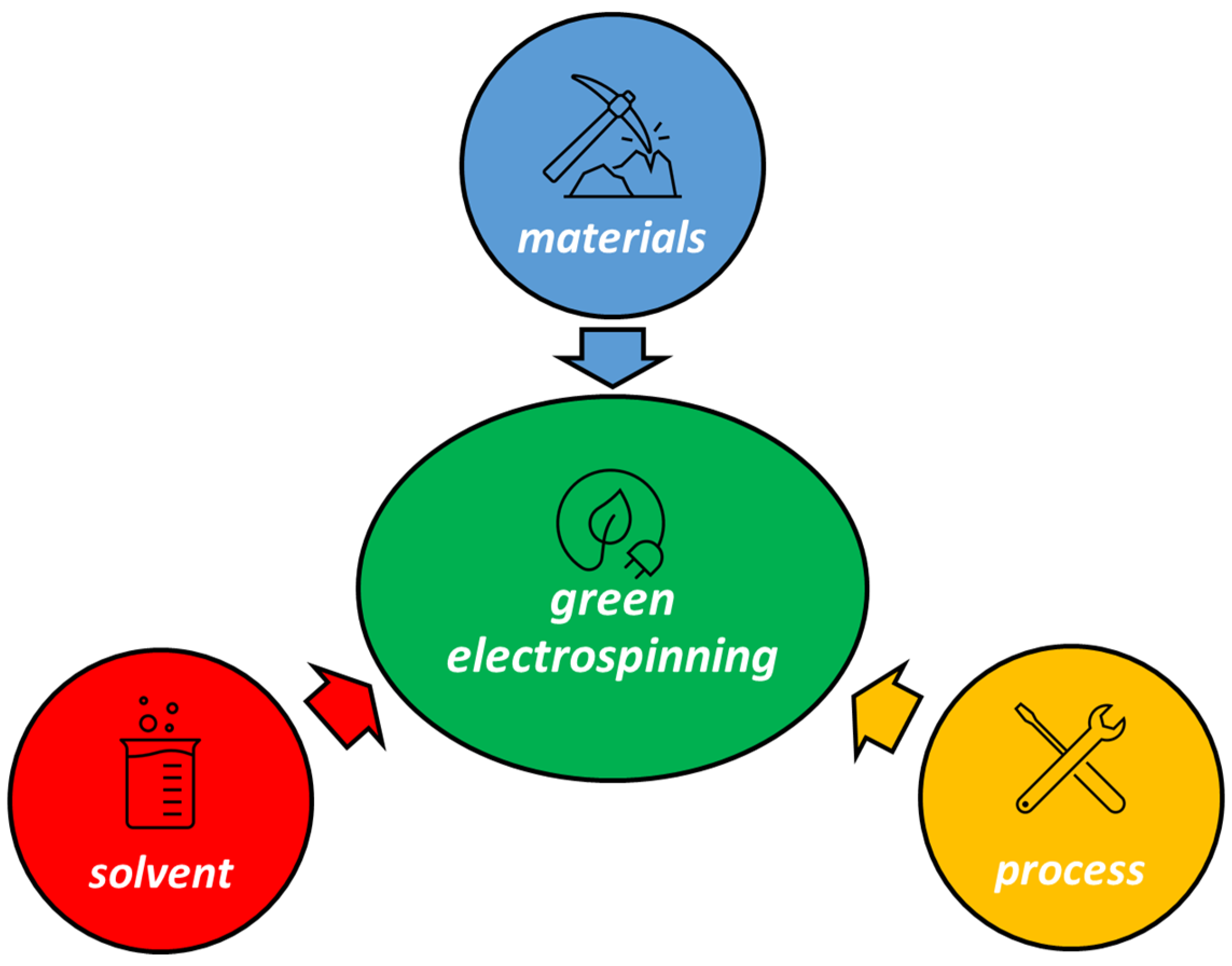
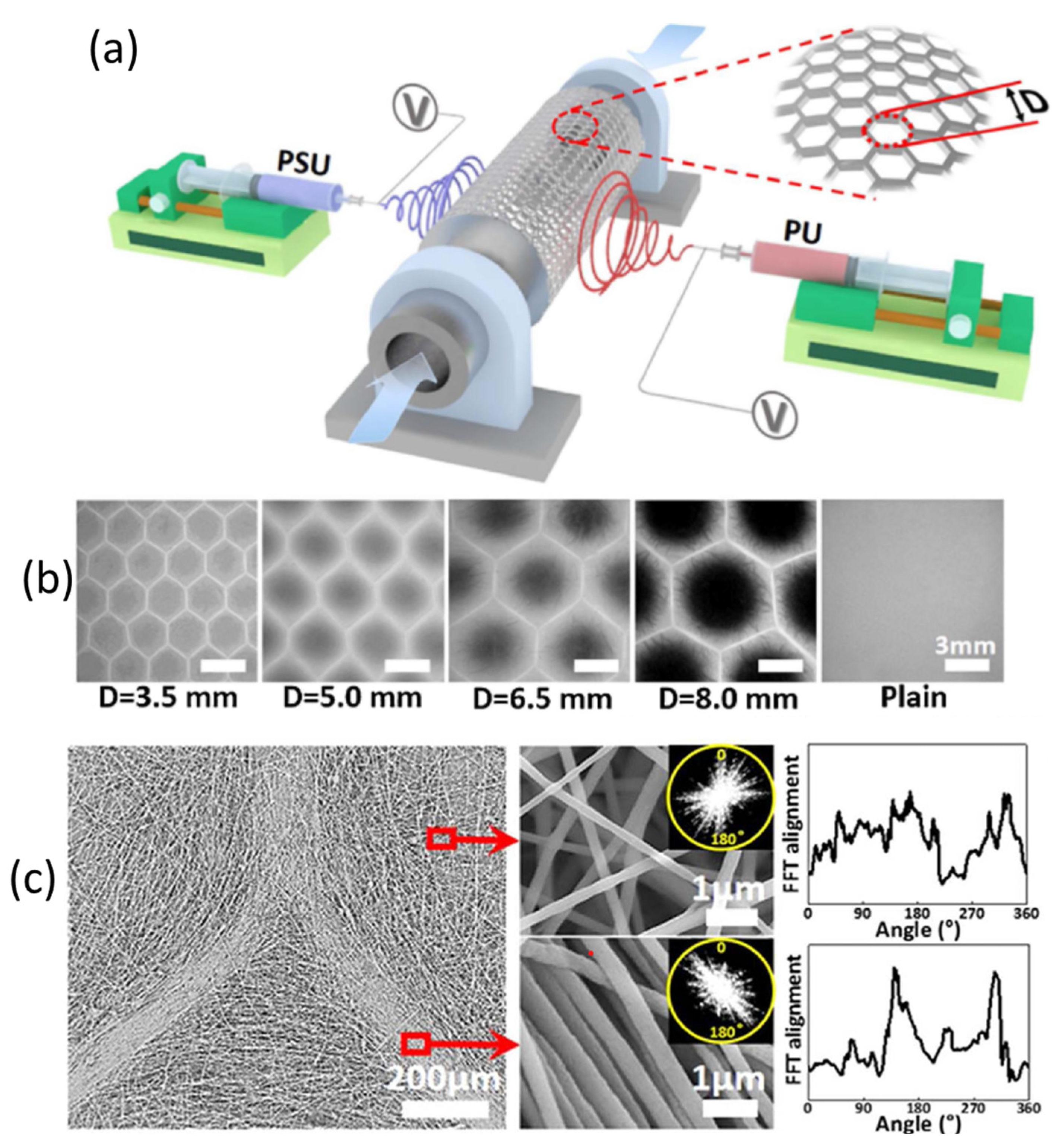
| Process Parameters | Effects on the Nanofibrous Membrane | Ref. |
|---|---|---|
| Applied electric field | An increase in the applied electric field results in thinner nanofibres due to the increase in electrostatic charge repulsion within the polymer jet. | [30] |
| Tip–collector distance | When the distance between the tip and the collector is increased, the flight time of the jet is increased as well as the time for the evaporation of the solvent. This reduces bead formation. | [31] |
| Viscosity of polymeric solutions, molecular weight, and polymer chain | Solution viscosity is related to polymer concentration and polymer chain entanglement. Fibre morphology is affected by these parameters. Uniform, bead-free fibres with larger diameters can be obtained at high polymer concentrations in the electrospinnable solution. | [32] |
| Flux rate | High flow rates produce beaded fibres due to the greater amount of solution that has to lose solvent during flight time. | [32] |
| Ambient temperature and humidity | Thinner fibres are produced as the temperature rises because the solvent evaporation rate increases. Humidity has a marked effect on the solidification process and therefore on fibre diameter. | [36] |
| Polymer | η (%) | ΔP (Pa) | QF (Pa−1) | Ref. |
|---|---|---|---|---|
| PAN | 99.99 | 110 | 0.100 | [54] |
| PAN | 99.99 | 92 | 0.100 | [55] |
| PAN | 99.71 | 40 | - | [41] |
| PVC | 94.33 | 154 | 0.19 | [56] |
| PA-56 | 99.995 | 111 | 0.891 | [57] |
| PVDF | 99.99 | 93 | 0110 | [58] |
| PLA | 98.56 | 29 | 0.140 | [59] |
| TiO2/PVA | 97.8 | 198 | - | [60] |
| Fe3O4/PVDF | 99.95 | 58 | 0.130 | [61] |
| GO */PI/PAN | 99.5 | 92 | 0.058 | [62] |
| PSU/PAN/PA-6 | 99.992 | 118 | 0.8 | [63] |
| Issue | Parameters | Effect on the Filtration Effectiveness |
|---|---|---|
| Characteristics of the nanofibrous membrane (See Section 5) | Thickness Porosity Surface roughness of fibres | Fluid flowing through the membrane is controlled by porosity, pore size distribution, and membrane pore tortuosity. Filtration efficiency increases when fibre diameter and pore size are smaller and pore tortuosity is greater. Exceeding these parameters can lead to excessive pressure drop and membrane fouling. The presence of protrusions on the surface of the fibres, causing surface roughness, increases the probability of interception of flow particles. |
| Material (See Section 6) | Pure polymer Polymer blend Organic–inorganic nanocomposite “Green” materials | Various pure polymers have been used to form nano-fibrous mats suitable for filtration. Polymer blends may have better filtration performance. Functionalised nanofibres can have a higher interception capacity, especially if there is a chemical affinity between the functional groups and the intercepting particles. Due to their large effective surface area, nanofibres can carry a large number of functional agents. The combination of inorganic compounds and polymers can have a beneficial effect on the filtration efficiency and mechanical properties of nano-fibrous membranes. Bio-based polymers, natural materials used as additives, and environmentally friendly solvents are preferable for a “green electrospinning” process. Although the filtration efficiency of “green membranes” can be higher, their mechanical properties are sometimes poor. |
| Membrane structure (See Section 7) | Monolayer of nanofibres Multilayer of nanofibres Multilayer of micro and nanofibres | To improve the mechanical properties of the monolayer electrospun membrane, it is preferable to use high-strength polymers, such as polypropylene. Alternatively, multilayer membranes can be used, also in combination with microfibre layers (e.g., surgical masks). Carbon fibres or other non-woven fabrics can be used as substrates for nanofibres. |
Disclaimer/Publisher’s Note: The statements, opinions and data contained in all publications are solely those of the individual author(s) and contributor(s) and not of MDPI and/or the editor(s). MDPI and/or the editor(s) disclaim responsibility for any injury to people or property resulting from any ideas, methods, instructions or products referred to in the content. |
© 2023 by the author. Licensee MDPI, Basel, Switzerland. This article is an open access article distributed under the terms and conditions of the Creative Commons Attribution (CC BY) license (https://creativecommons.org/licenses/by/4.0/).
Share and Cite
De Riccardis, M.F. Electrospun Nanofibrous Membranes for Air Filtration: A Critical Review. Compounds 2023, 3, 390-410. https://doi.org/10.3390/compounds3030030
De Riccardis MF. Electrospun Nanofibrous Membranes for Air Filtration: A Critical Review. Compounds. 2023; 3(3):390-410. https://doi.org/10.3390/compounds3030030
Chicago/Turabian StyleDe Riccardis, Maria Federica. 2023. "Electrospun Nanofibrous Membranes for Air Filtration: A Critical Review" Compounds 3, no. 3: 390-410. https://doi.org/10.3390/compounds3030030
APA StyleDe Riccardis, M. F. (2023). Electrospun Nanofibrous Membranes for Air Filtration: A Critical Review. Compounds, 3(3), 390-410. https://doi.org/10.3390/compounds3030030





